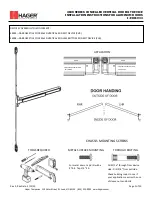
Page 14
10. Electrical
Controls
(cont'd)
interlock the system when an outside overhead door reaches approximately
80% of full open travel. The switch will de-energize the system when the over-
head door closes approximately 20%. Follow the installation instructions in
the door switch option package and the wiring diagram.
Firestat (Option BD5)
If the system has an optional firestat, the control is factory installed in the
heated airstream so that the sensor extends into the duct. This control requires
manual reset so is installed in an accessible location.
Optional Potentiometer (applies to systems with Air
Control Option AR19 for makeup air only or AR22
for outside and recirculation air)
If the system includes Air Control Option AR19, the discharge damper is con-
trolled by a manually set potentiometer. If the system includes Air Control
Option AR22, the potentiometer controls the return air damper. The potenti-
ometer is shipped loose in the control compartment, or if a remote console is
ordered, it is mounted on the console.
Follow the wiring diagram to connect the potentiometer.
Optional Pressure Null Switch (applies to systems
with Air Control Option AR20 for makeup air only or
AR23 for outside and recirculation air)
If the system includes Air Control Option AR20, the discharge damper is con-
trolled by a pressure null switch. If the system includes Air Control Option
AR23, the pressure null switch controls the return air damper. The pressure
null switch is shipped in the control cabinet. Refer to the following paragraphs
and to the manufacturer's installation instructions to install and connect this
switch.
The pressure null switch is Dwyer #1460-0 with a range of .01-.12" w.c. The
pressure null switch is a diaphragm operated differential pressure switch used
in makeup air applications to control building pressure. It maintains a selected
positive or negative pressure setpoint by changing the amount of outside air
being introduced to the building through the modulating outside air dampers.
As more pressure is required in the building, the pressure null switch activates
the damper motor driving the outside air damper towards the full open posi-
tion and the recirculated air damper towards the closed position. Conversely,
as less pressure is required, the switch drives the dampers in the opposite di-
rection.
FIGURE 15
- Optional
Firestat
FIGURE 16 -
Optional
Potentiometer
FIGURE 17 - Pressure
Null Switch
Installation Instructions for
Pressure Null Switch (See
FIGURE 18):
Select an indoor location free from excessive vibration where oil or water will
not drip on the switch and where ambient temperature will be within a range of
-30°F (dry air) to 110°F.
Mount the switch with the diaphragm in a vertical plane. The switch is position
sensitive and is calibrated to operate properly when the diaphragm is vertical.
Mount switch securely.
Connect the pressure taps on the top of the switch to sources of air pressure
differential. Metal tubing with 1/4" O.D. is recommended but any tubing which
will not unduly restrict the airflow can be used. To maintain a positive building
pressure, vent the low pressure tap to the outdoors and allow the high pressure
tap to monitor building pressure. To maintain a negative building pressure,
reverse the functions of the high and low pressure taps. In either case, be sure
that the outdoor vent is protected from the wind and screened from insects.
Door Switch (cont'd)














































